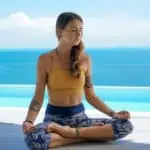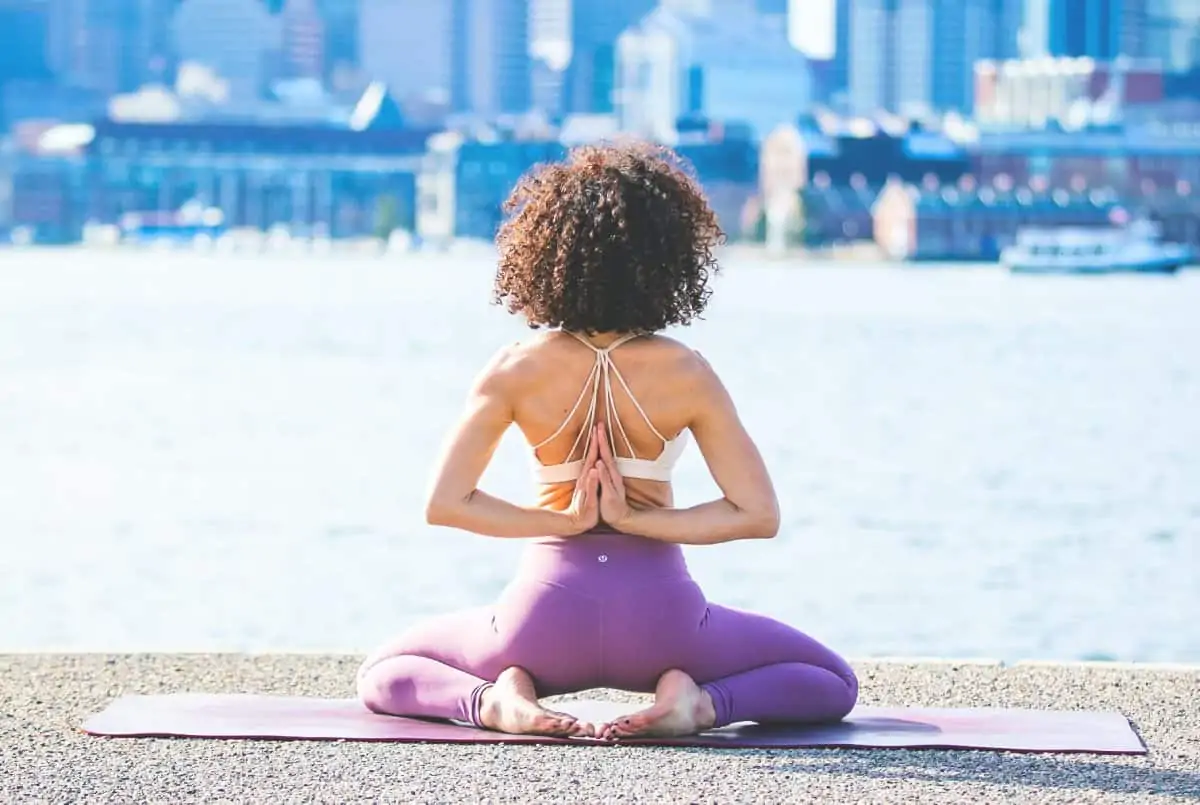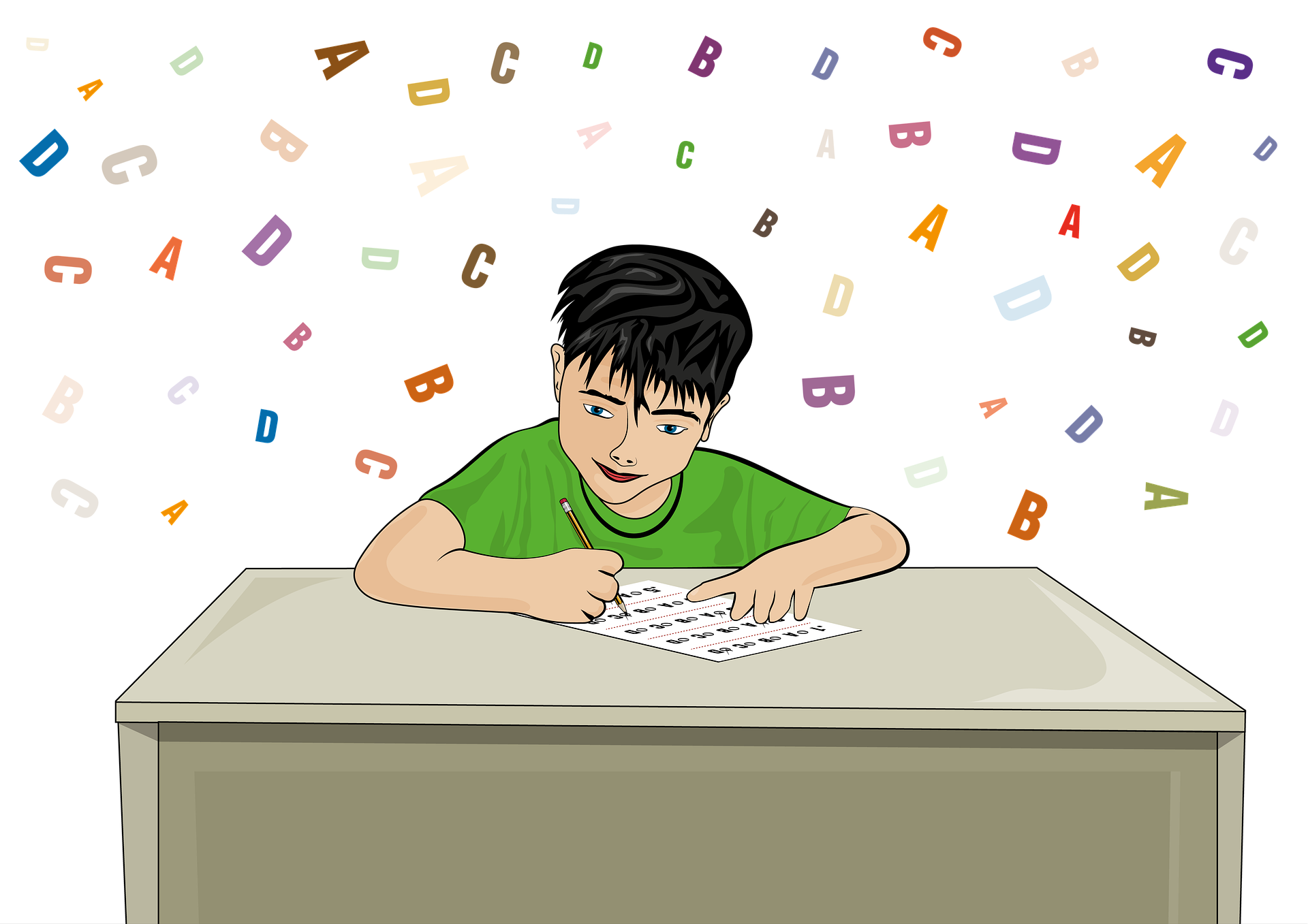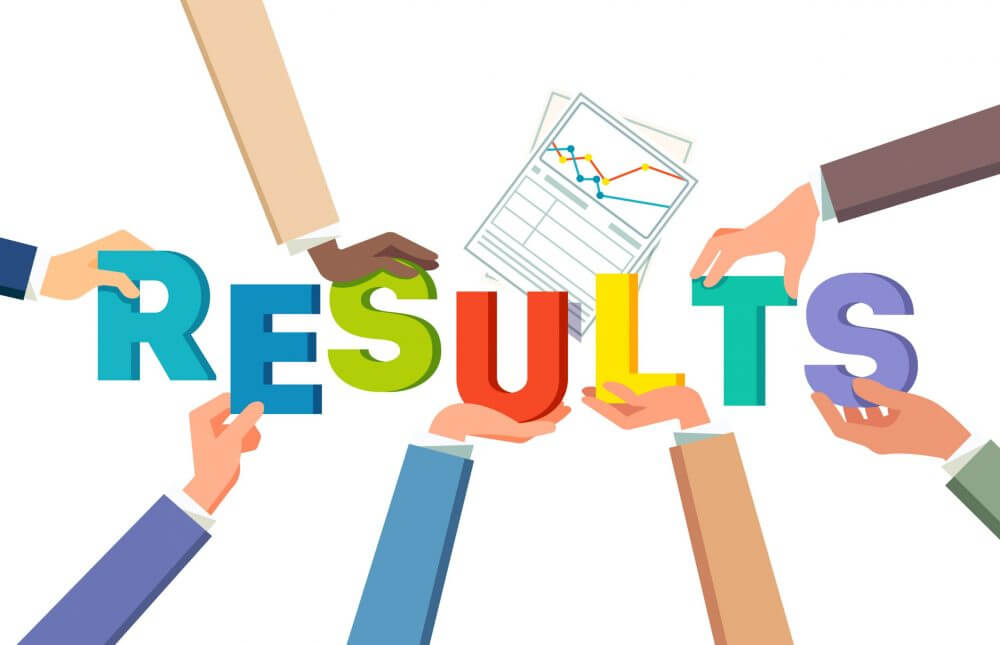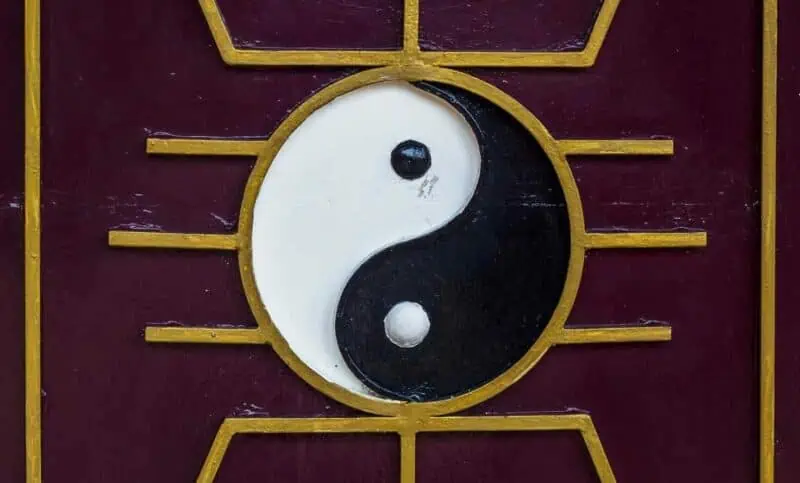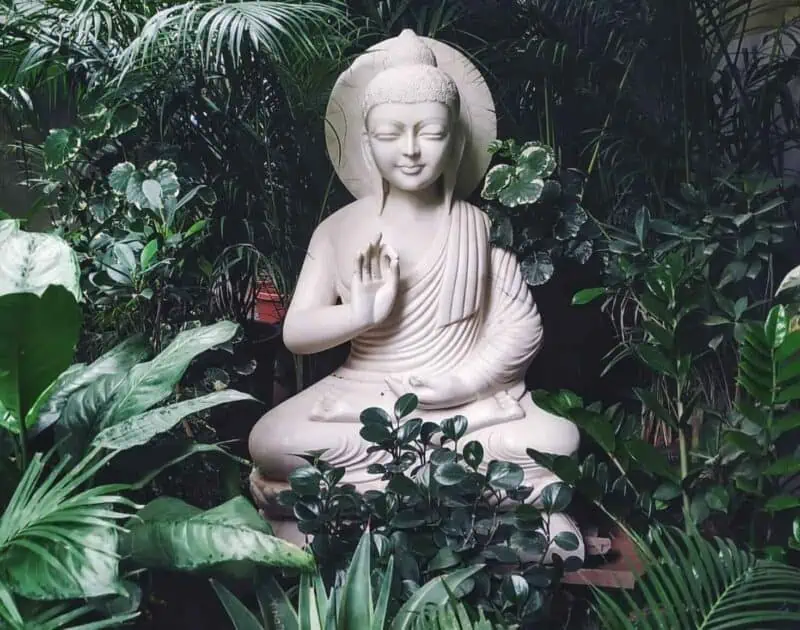Listen to this article:
Key Takeaway
Slow-flow yoga combines the rhythm of traditional yoga with a slower pace, enhancing mindfulness and relaxation.
Have you ever been in a yoga class where the flow was moving so quickly you couldn’t keep up? “I thought yoga was supposed to be relaxing”, you think to yourself, yet you feel a little bit stressed just trying to keep up with all the sun salutations and chaturangas.
This is what drew me to slow flow yoga: a type of yoga that offers all the benefits of vinyasa while giving you more time to pause, adjust, and breathe. Slow flow yoga is deeply relaxing and easier for beginners to follow. It also helps you connect more deeply with your body, breath and inner journey.
In this ultra-fast world, we need slow flow yoga to rebalance and relax. Let’s dig deeper into the soul of slow flow yoga. Here we’ll cover:
- What is slow flow yoga?
- 10 benefits of slow flow yoga
- Pros and cons of slow flow
- Slow flow vs. power yoga vs. vinyasa
- Slow flow vs. yin yoga
- How to practice slow flow yoga
- A slow flow sequence for beginners
Contents
- 1 What is Slow Flow Yoga?
- 2 10 Benefits of Slow Flow Yoga
- 2.1 More time to focus on alignment:
- 2.2 Gradual warmup:
- 2.3 Mindfulness and awareness:
- 2.4 Improves strength in muscle fascia and joints:
- 2.5 Suitable for all age groups:
- 2.6 Synchronization of breath and movement:
- 2.7 Easier to use props or modifications:
- 2.8 Improves oxygenation of blood:
- 2.9 Reduces stress:
- 2.10 Repetition:
- 3 Pros and Cons of Slow Flow
- 4 Slow Flow vs. Power Flow Yoga vs. Vinyasa
- 5 Slow Flow vs. Yin Yoga
- 6 How to Practice Slow Flow Yoga
- 7 Slow Flow Sequence for Beginners
- 7.1 Begin in Mountain Pose (Tadasana)
- 7.2 Raised Arms Pose (Urdhva Hastasana)
- 7.3 Standing Forward Bend (Uttanasana)
- 7.4 Half Lift (Ardha Uttanasana)
- 7.5 Plank Pose (Phalakasana)
- 7.6 Chaturanga (Chaturanga Dandasana)
- 7.7 Upward Dog (Urdhva Mukka Svanasana)
- 7.8 Downward Dog (Adho Mukha Svanasana)
- 7.9 Half Lift (Ardha Uttanasana)
- 7.10 Forward Fold (Uttanasana)
- 7.11 Raised Arms Pose (Urdhva Hastasana)
- 7.12 Mountain Pose (Tadasana)
- 8 The Importance of Music in Slow-Flow Yoga
- 9 Exploring Mindfulness Through Slow Flow Yoga
- 10 Top Slow Flow Yoga Videos
- 11 Slow Down and Savor the Moment
What is Slow Flow Yoga?
Slow flow yoga is a low-impact yoga workout excellent for beginners and those seeking stress relief, as well as children and elderly yogis. It still has the rhythm of yoga without the rush.
Your joints and muscles gradually warm up over a longer period and you have more time to perfect your alignment in each pose. Slow flow yoga still helps you improve mindfulness, breathwork, flexibility, balance, and strength, but it does so in a less intensive way than other styles.
Slow flow is all about slowing down and concentrating on your mind-body connection. New students, or those with a more contemplative disposition, will gravitate toward slow flow yoga as a way to go deeper in their practice. On the other hand, advanced students and those with a more fast-paced or athletic disposition may find slow flow to be lacking challenge and not offering enough of a workout.
10 Benefits of Slow Flow Yoga
More time to focus on alignment:
There is simply more time between transitions and a slower pace than typically vinyasa or power yoga classes
Gradual warmup:
Slow flows allow your muscles to warm and flex more gradually, resulting in less lactic acid buildup, therefore less fatigue.
Mindfulness and awareness:
The dance and rhythm of slow flows help bring you into a meditative state by slowing your heart rate and bringing attention to your thoughts.
Improves strength in muscle fascia and joints:
Smaller muscle groups are targeted through strategic movements and isometric exercises when holding poses for longer periods.
Suitable for all age groups:
Slow flow is especially great for children or elderly groups who need a slower pace and more time to explore different asanas.
Synchronization of breath and movement:
Yoga comes from the Sanskrit word “to yolk”. This style of yoga especially embodies the “yolking” or bringing together of mind-body-spirit through synced breathing and motion.
Easier to use props or modifications:
You can modify poses to fit your needs without feeling rushed.
Improves oxygenation of blood:
Deep breathing that coordinates with movements in or out of asana increases lung capacity and the amount of oxygen in your blood.
Reduces stress:
In a fast-paced world, we could all use a little more slowing down and releasing to the flow of the universe.
Repetition:
Like many vinyasa classes, slow flow often repeats the same sun salutations or sequences multiple times. The repetition brings more bodily awareness and opportunities to delve deeper into poses.
Pros and Cons of Slow Flow
Pros
- Accessible for beginners and all age groups
- Easy to follow pose transitions
- More relaxing than power yoga
- More time to adjust and sink into specific asanas
- Improved concentration and awareness
- Ample time to meditate and self-evaluate
- Improves balance during longer hold times
- Targets smaller muscle groups and muscle fascia
- Improves joint health
- Improves stress response
- Oxygenates the blood
- Helpful for people with back pain
- Easy to learn
Cons
- Less strength building (compared to power yoga)
- Less cardiovascular workout
- May not be challenging enough for advanced yogis
- Meditative practice is needed to keep the mind from wandering
Slow Flow vs. Power Flow Yoga vs. Vinyasa
Vinyasa is the traditional form of flow yoga; sort of like the broader category that slow flow and power flow rest underneath. To flow simply means to sort of dance or elegantly move the body between postures that have been strategically designed in sequence.
There is an art to flow. It is a fluidity in transitions that helps the body open up and become less rigid.
Slow flow and power flow yoga are two opposite ends of the Vinyasa spectrum, but the speed and intensity of each can vary widely among different teachers and classes.
Slow flow is all about grounding, stable energy. The focus is primarily on balance and safe alignment. The sequences move slower and may hold poses for longer. There is also more time to use props like yoga blocks and bolsters.
Slow flow yoga warms up your muscles gradually and may slightly raise the heart rate, but it is not really a cardiovascular or strength-building workout.
On the other hand, power yoga is much more athletic, vigorous, strengthening, and intense. Power yoga is more of a workout than a relaxation practice, though it provides both. There is less focus on meditation and more focus on dynamic movements.
Your heart rate will raise more quickly as you transition between poses, not holding any one posture for very long but likely returning to the same posture many times. It helps to already have mastered alignment in power yoga asanas because there is not much time to make adjustments.
Slow Flow vs. Yin Yoga
Far opposite of power yoga, yin yoga is inspired by ancient Chinese Taoist practices that were also used in Kung Fu training for thousands of years. It involves holding yoga poses and stretches for a long length of time.
Yin practitioners often stay in an asana for 3 to 5 minutes, or even more. This is especially useful for balancing the nervous system and targeting connective tissues during periods of rest in long-held postures.
If you think of the taijitu (the “yin-yang” circle), yin is the black feminine resting side of this duality, whereas yang is the white masculine muscular movement type of yoga represented in most studios across the U.S.
Power yoga, vinyasa, and Ashtanga are all very “yang”. Yin yoga is much more subtle and in-depth. Slow flow yoga lies somewhere between this spectrum, with equal balances of both types of energy.
Yin yoga is very still. Slow flow yoga is active, yet unhurried. Both yin and slow flow yoga include very slow, easy poses, however yin does not does not “flow” between the sequence. Yin yoga involves holding deep stretches for long periods of time (several minutes or more), whereas slow flows may hold asana for just a few rounds of breath.
How to Practice Slow Flow Yoga
To practice slow flow yoga, you will want to begin with a yoga mat and maybe a few props (such as yoga blocks or a yoga strap) to help you maximize the benefits of certain poses.
Slow flow sequences are typically about half the number of poses you would practice in a typical vinyasa class. A deep, mindful sequence will help you feel calm, focused, and revitalized.
The key to experiencing all the benefits of slow flow yoga is release. We must be able to let go and savor the gradual pace, enjoying a more passive meditative experience that can stay with us even after leaving the mat.
“Letting go gives us freedom, and freedom is the only condition for happiness. If, in our heart, we still cling to anything – anger, anxiety, or possessions – we cannot be free.” – Thich Nhat Hanh
Slow Flow Sequence for Beginners
The easiest way to begin slow flow yoga is with a very simple sun salutation. Rather than moving with every single breath, each pose will be held for several rounds of breath in and out.
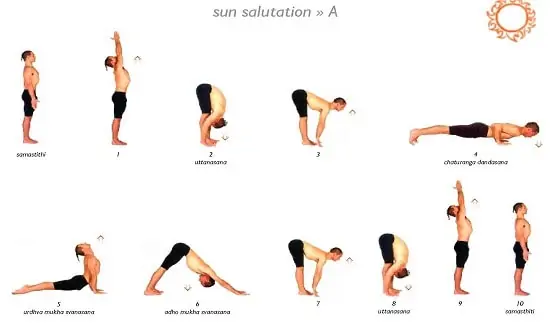
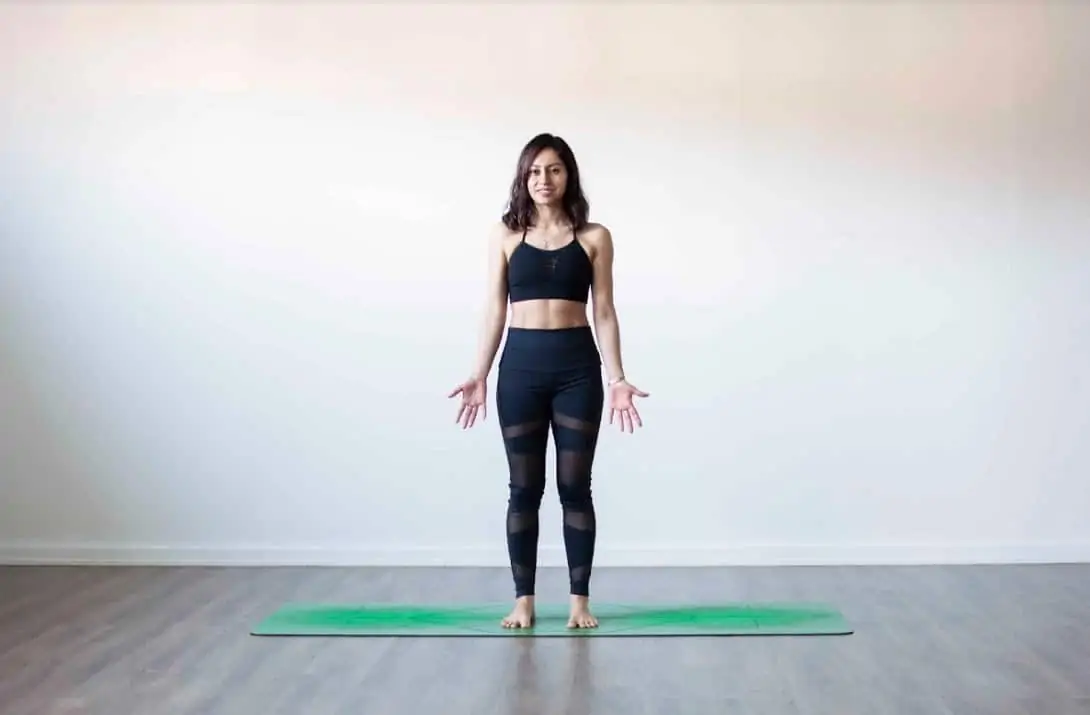
Begin in Mountain Pose (Tadasana)
Stand with feet together or hip-width apart, hands open and relaxed to your sides. Take 3 long slow breaths.
Raised Arms Pose (Urdhva Hastasana)
On your 4th inhale, bring your arms out to the sides and meet your palms together above your head. Pull your shoulders down away from your ears, feeling the shoulder blades against each other. Hold for 3 gentle breaths.
Standing Forward Bend (Uttanasana)
On the 4th breath, inhale and then exhale down, folding forward over your legs. Slightly bend the knees and reach for the floor. If you can’t reach the floor, use a block or place hands on shins. Breathe for 3 rounds.
Half Lift (Ardha Uttanasana)
On an inhale, slowly lift your head to look forward. Straighten your spine, engage the core, and half lift your body with fingertips on the floor or on your shins. Hold for 3 slow rounds of breath.
Plank Pose (Phalakasana)
On the 4th breath, inhale, place the hands flat on the floor, and walk feet back to plank pose. Shoulders should be aligned over your wrists and toes beneath the heels. Back is straight. Core engaged. Hold for 3 slow breaths, feeling the muscles strengthen.
Chaturanga (Chaturanga Dandasana)
On an exhale, bend the elbows directly by your sides and lower the chest and chin toward the ground as if a low push-up (optional to drop the knees for support). Keep your butt up high and elbows hugging against your ribcage. Hold for 2 slow breaths, embracing any shaking or wobbling in the muscles.
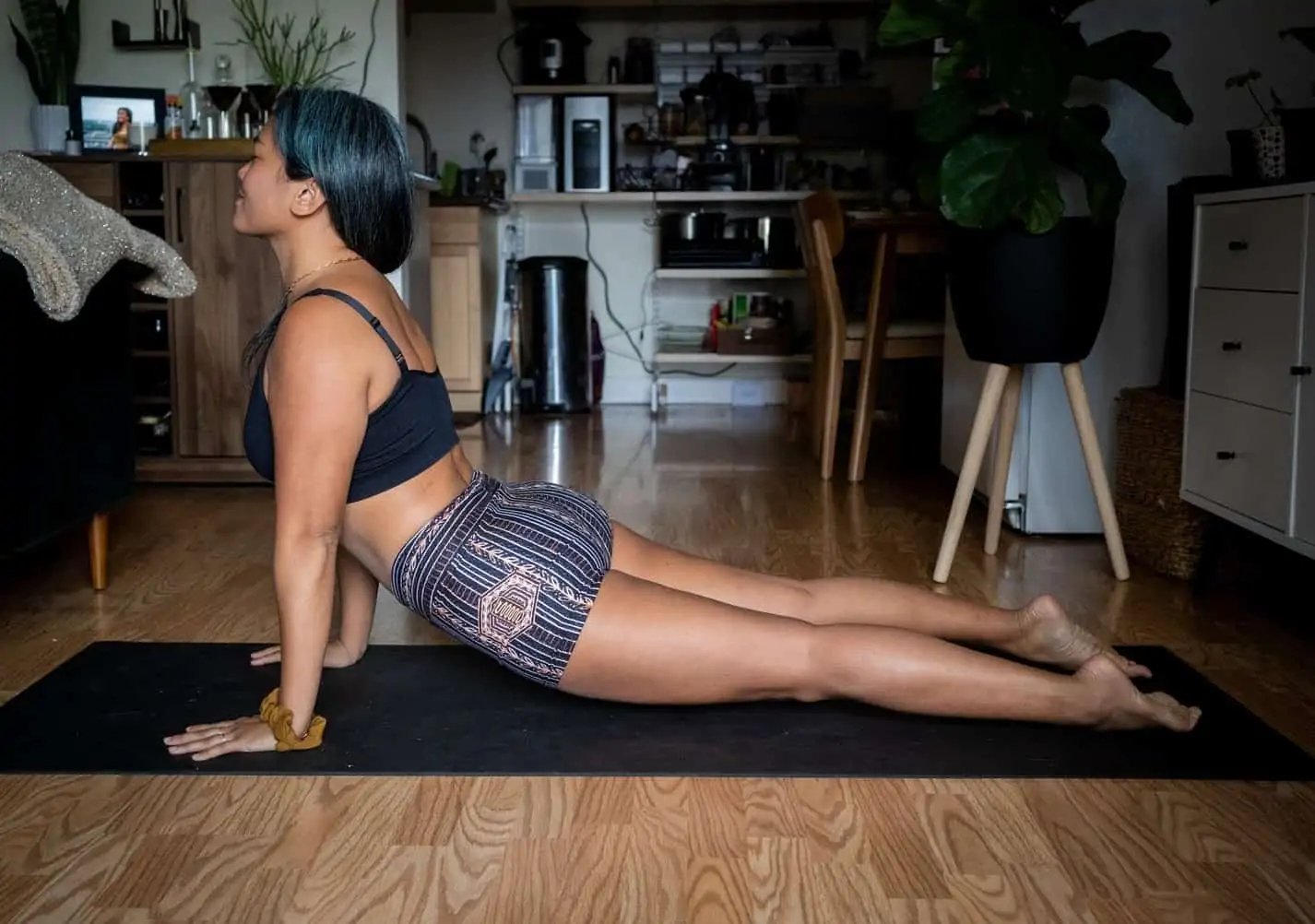
Upward Dog (Urdhva Mukka Svanasana)
On an inhale, very gradually roll over your knees onto the top of the feet and reach your head upward, straightening the arms and rolling shoulder blades down and back. The thighs should be lifted and engaged, or if this is too challenging, rest the thighs on the floor in Cobra pose (Bhujangasana). Take 3 long slow breaths, feeling the heart and spine open up.

Downward Dog (Adho Mukha Svanasana)
On an inhale, push backwards into a downward dog, palms pressing into floor and tailbone reaching toward the sky. Shoulders should be away from the head, shoulder blades engaging in the back, and heels pressing toward the ground to open your hamstrings. You can “walk the dog” by slowly pressing one heel down and then the other. Breathing very slowly for 5 rounds of breath. Take time to pause, hold, and reflect in your first inverted position.
Half Lift (Ardha Uttanasana)
On the next inhale, gently walk your feet forward to the front of the mat and return to the half-lift position, gaze forward, holding for a few breaths with the core engaged.
Forward Fold (Uttanasana)
On the next exhale, release and breathe. Feel your hamstrings opening a bit more as you relax downward for 5 slow inhales and 5 slow exhales, sinking deeper with each breath.
Raised Arms Pose (Urdhva Hastasana)
Hinge at your hips to stand back up, raising the hands over your head. Slight backbend optional. Breathe for 3 breaths, stabilizing the feet and hips.
Mountain Pose (Tadasana)
On the last exhale, let your arms release down to your side. Return to mountain pose, full circle to where we began. Breathe deeply for 5-10 breaths, letting your mind release any lingering thoughts and softening your gaze forward.
The Importance of Music in Slow-Flow Yoga
In slow-flow yoga, music isn’t merely background accompaniment; it serves as a tool that directs the movement, enriches the breathing process, and elevates the practice.
In my classes, the teacher thoughtfully picks music that complements the rhythm and ambiance of the session. The gentle melodic melodies aid in syncing breath with motion, fostering a state that may be challenging to achieve.
Music also aids in concentration. In a fast-paced world where our minds are constantly busy, appropriate music can help ground our thoughts and keep us engaged in the present moment.
Additionally, music stirs emotions. It has the power to uplift our mood during poses or soothe us during relaxation periods. Each session unfolds like a voyage, with music serving as our compass.
This aspect of slow-flow yoga warrants more recognition. It’s not just about postures or breathing techniques; it’s about cultivating an environment that nurtures peace. Music plays a role in this process, transforming each practice into a soulful experience.
Exploring Mindfulness Through Slow Flow Yoga
Embracing Mindfulness in a Gentle Flow
As I stepped onto the yoga mat for the first time, my mind was filled with a whirlwind of thoughts. From contemplating my day and to-do list to worrying, I found it challenging to stay fully present. It was during this moment that I experienced the impact of mindfulness in flow yoga. It wasn’t about moving; it was about immersing myself completely in each breath and movement.
Attentive Listening and Being Present
In slow-flow yoga, we are encouraged to listen to our bodies. This involves recognizing the changes in our muscles and breath as we transition between poses. It’s about fostering curiosity. When we embrace curiosity, we embody presence. Through our presence we cultivate mindfulness.
Taking Time to Foster Inquisitiveness
Slowing down during our practice allows us to nurture our sense of curiosity. Each pose becomes an opportunity for exploration: “How does this pose resonate with me?” “What happens if I deepen my breath?” These inquiries keep us engaged and grounded in the moment. This sense of curiosity extends beyond the yoga mat, empowering us to approach life with a renewed outlook and an open mind.
The Concept of Mindful Presence
When practicing flow yoga with mindfulness, we learn to embrace the moment both literally and symbolically. The key is to acknowledge our state without criticism. This acknowledgment can bring a sense of serenity and fulfillment that has the potential to alter our lives. It serves as a nudge that slowing down can lead us to awareness, happiness, and a stronger bond, with ourselves and the environment.
Integrating mindfulness into our slow-flow routine elevates it beyond a workout to a spiritually enriching journey. It extends beyond performing poses; it encompasses how we engage with every instant, whether on the mat or in life.
Top Slow Flow Yoga Videos
Best for Beginners:
Best for Flexibility:
Best for Intermediate Yogis:
Best for Evening Yoga:
Best for Yin/Slow Flow Blend:
Slow Down and Savor the Moment
Even us yogis can sometimes get caught up in the rush of an exciting power yoga workout or the bustle of a crowded studio. Slow flows remind us to go with the flow of the universe and settle in for some silence and reflection.
Namaste!
Pop quiz! 🧘🤔
Slow flow yoga is only suitable for advanced yogis.
Slow flow yoga can help improve mindfulness and breathwork.
Slow flow yoga does not incorporate any elements of meditation.

